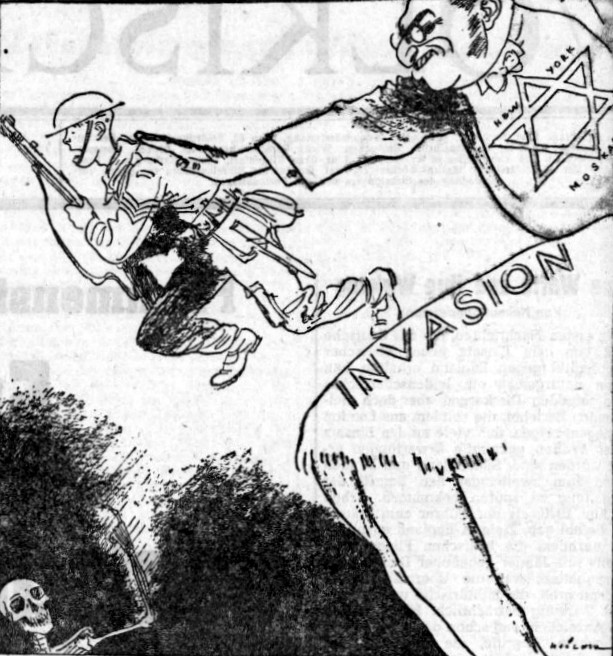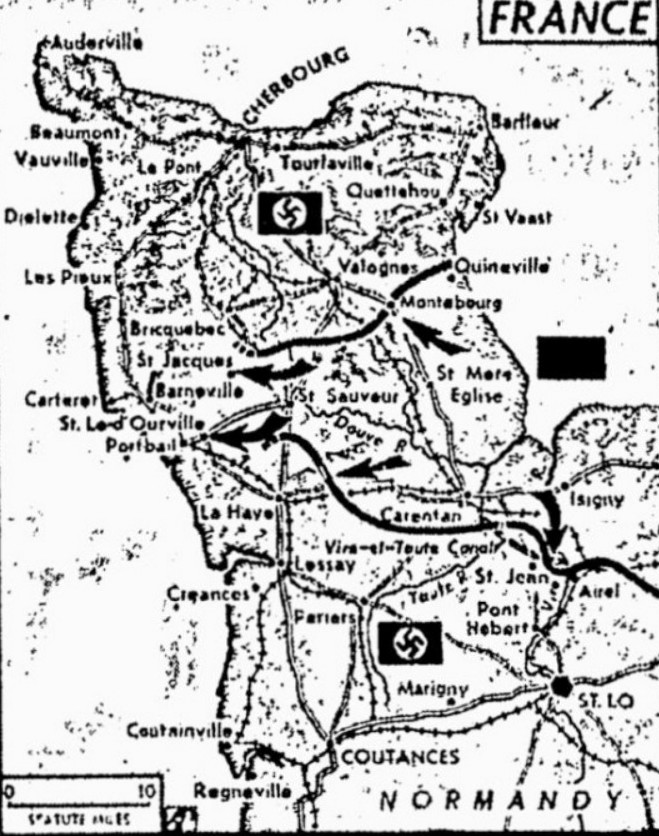LIFE (June 19, 1944)
Gen. Hawley provides quick care for wounded
By Mary Welsh
London, England –
There are thousands of American fighting men slogging through the invasion who, next year or some year soon after, will be home again, living their lives peacefully without any dog tags. In any previous war, these same men would never go home. Their post-war identification would be a fixed cross with their name, rank and serial number.
These returning thousands will be composed of the men hospitalized for battle wounds who this time will not die. The Army Medical Corps has reduced the death rate of hospitalized wounded from 8% in World War I to 3% in World War II. There are many more casualties who, if injured in 1918, would have been long invalided. In 1944, these wounded will recover quickly and completely.
The man who, more than any other, is responsible for pushing back these margins of pain, disability and death on the second front is a solid, freckle-faced surgeon named Paul Ramsey Hawley, who is a major general in the U.S. Army. Gen. Hawley comes from College Corner, Ohio, a town he likes. He also likes precision in speech, medicine and manners, The Diary of Samuel Pepys, his job. He came to England from Pennsylvania’s Carlisle Barracks in September 1941 to study English medical methods under the Blitz. After Pearl Harbor, Hawley stayed on to become chief U.S. Army surgeon in the European Theater. As head ETO surgeon, Gen. Hawley has assembled in one vast organization some of the top U.S. talent in surgery. He has also assembled medicine and huge stores of blood plasma, sulfa drugs, penicillin and new anesthetics like sodium pentathol which can go to forward-zone hospitals because its use does not require elaborate equipment. But Gen. Hawley and his chief surgical consultant, inexhaustible Col. Elliott Cutler of Harvard’s Medical School, put only a portion of their faith in medicine alone. They know how necessary good surgery is in treating battle casualties.
Gen. Hawley has keyed his entire organization to the principle that the earlier the surgery on many types of wounds, the better the soldier’s chance of full recovery. His watchword is: “Get the surgeon to the patient, not the patient to the surgeon.” The invasion wounded will not have to undergo unnecessary feats of endurance, for Gen. Hawley has worked out a “chain of evacuation” system to insure them speedy medical treatment and surgery. His gentle-handed legions of first-aid men, litter bearers, ambulance drivers, hospital train and aircraft crews are skilled in moving casualties quickly and with expert precision. His doctors’ system of sorting wounds quickly routes soldiers in need of immediate surgery to completely equipped hospitals only a few miles behind the front.
In Gen. Hawley’s “chain of evacuation,” there are 10 halting places. In every one of them, and en route between, men may be treated according to their needs. Most wounded will bypass several of them.
The Hawley chain is composed of: 1) first-aid men, 2) litter bearers, 3) battalion aid stations, 1,000 yards or less from the front, 4) division clearing stations, about eight miles back, 5) evacuation hospitals, 15 to 30 miles behind the lines, 6) field hospitals, paralleling the evacuation hospitals, 7) hospital trains and ships, 8) station and general hospitals in secure areas where patients may remain six months if necessary, 9) convalescent hospitals, 10) the United States of America.
First-aid men, one for each platoon of infantry, move onto the battlefield just behind the fighters. In paratroop outfits they jump with the soldiers. Under shells, bombs and mortar fire, they give instant aid to the wounded. If a casualty can walk, he goes with temporary dressing to the battalion aid station by himself. If he can’t walk, the first-aid man makes him comfortable, with morphine if necessary, then directs litter bearers to him.
At battalion aid stations, doctors, working in tents or available buildings, give treatment for shock, control hemorrhage, relieve pain, administer transfusions, immobilize fractures. These numerous small units do not attempt major surgery. They simply prepare the wounded for traveling in the greatest possible comfort.
The first real wound-sorting nation in the evacuation chain is the division clearing station, whose functions are similar to those of an emergency room in big city hospitals. Here experts in wound-diagnosis decide which men need priority in travel and treatment, which can more safely wait. Meanwhile, they change dressings, check tourniquets, prevent infection, relieve pain. Most soldiers hit by ordinary bullets feel little pain for the first couple of hours.
From division clearing stations, all but the most lightly wounded move back in ambulances to evacuation hospitals, two or three hours behind the front. Here doctors are equipped to do major surgery, but since evacuation hospitals must be ready to move with the troops, they take in only men they expect to recover quickly. Annexed to each evacuation hospital is a field hospital which stays stationary longer. To these field hospitals go urgent chest and abdominal cases who will not be moved until they are out of danger.
From either evacuation or field hospitals the way back from the front is comparatively smooth. Shining, clean hospital trains and ships heavily staffed by nurses and doctors take casualties to big station and general hospitals in England where there are experts in every type of medicine and surgery, either on staff or on call. Many of these large U.S. hospitals, now quartered in Nissen huts in England, complete with their own kitchens, laundries and electric power plants, are scheduled to follow the invasion across the channel.
To save travel, the rule of the chain of evacuation is that the patient must be evacuated no farther to the rear than his condition warrants. But sulfa drugs, penicillin and other new methods of treatment now make it safe and virtually painless for many men to travel far distances before they get definitive treatment. For instance, brain wounds may cause no pain at all, since no sensory nerves are in the brain. Thus, if they are not otherwise hurt and if sulfa has been administered early, men with shrapnel in their heads may now travel straight back to the big hospital.
Gen. Hawley’s statistical staff has figured out from its African and Italian experiences, just how many of what kind of patients invasion doctors may expect and what the hazards of their injuries are. They have learned that high explosives – bombs, shells, mines and mortar – cause 82% of all wounds, small arms only 18%, and that the soldier is most apt to be hit in the arms or legs. They know, too, that 15% of all combat casualties receive abdominal, pelvic and chest wounds and that these are the cases which must be most quickly attended. In the last war, the AEF mortality rate from abdominal and pelvic wounds was 43%. During three months of hard fighting in Africa last year, the U.S. Army Medical Corps managed to hold the rate to 21%. With his mobile, forward-zone field hospitals, Gen. Hawley hopes to reduce this percentage even further. On the second front, soldiers with serious abdominal and chest wounds will reach the operating tables of these field hospitals a scant two or three hours after they are hit.
Without the strictest adherence to military precisions and what the Army calls SOP (Standard Operational Procedure), Gen. Hawley’s complex organization could never work. Except in big hospitals, a patient may never be attended by the same doctor twice. The nurse who puts on a bandage may be 50 miles away when it is taken off. To ensure that the treatment of any type of injury or illness “be continuous and conform to one plan rather than altered with each change of medical officers.” Hawley and his staff compiled a Manual of Therapy which standardizes every medical treatment and surgical operation down to the kinds of anesthetics to be given, the exact amount of drugs, types of bandages, kinds of stitches, sixes of shrapnel to be removed.
The manual recommends surgical techniques which a few years ago were considered revolutionary. Proof that these practices are correct is provided by corps of experts in toxicology, pathology, bacteriology, serology, parasitology and entomology. They deal with problems too complicated for average hospital laboratories, hunting down every evidence of unusual diseases, rare germs, worms, bugs. They are the Army’s insurance against outbreaks of food-poisoning or amebic dysentery, typhoid, dozens of other epidemics.
Some of Gen. Hawley’s specialists are searching for the cause of otitis, an inflammation of the ear which grounds a high percentage of fliers and sometimes makes them deaf. Another expert is studying the behavior of typhus virus, imported from Naples. Typhus has been reported in eastern Germany and Gen. Hawley wants all possible answers on how to treat it and the other diseases which may develop in starved, overcrowded Europe.
Just before D-Day, Gen. Hawley said of this great medical machine which he has spent two years in perfecting:
It’s like a beautiful ship, ready on the ways for launching. Let’s hope it doesn’t go aground or capsize.
As D-Day came and went and the wounded eddied quickly back from the first invasion wave to beachhead battalion aid stations and to floating hospitals completely equipped with clamped-down operating tables, it was apparent that Gen. Hawley’s “beautiful ship” was doing a beautiful job indeed on its crucial first run.

